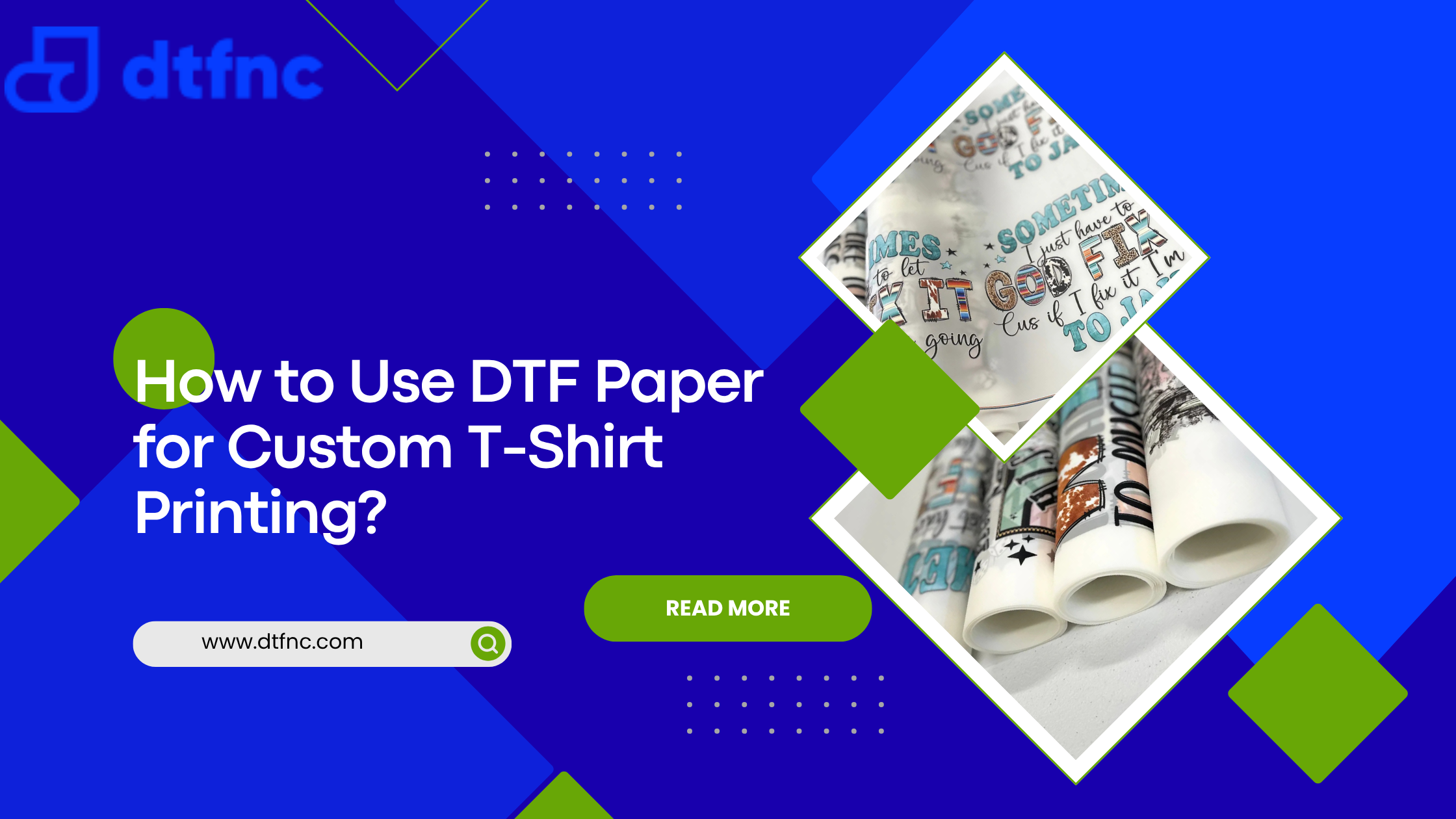Direct to Film (DTF) printing has gained significant popularity in the world of custom apparel and fabric printing due to its versatility and high-quality results. However, like any printing technology, DTF is not without its challenges.
Most Common DTF Printing Problems and Solutions
Direct to Film (DTF) printing has gained significant popularity in the world of custom apparel and fabric printing due to its versatility and high-quality results. However, like any printing technology, DTF is not without its challenges. In this blog post, we will explore the most common DTF printing problems and provide practical solutions to help you overcome these issues and achieve optimal printing results.
DTF Printing Problem #1: Ink Smudging

Problem:
One of the prevalent issues in DTF printing is ink smudging, which can ruin the quality of your prints. This problem often occurs when the ink is not drying properly or when excessive ink is applied.
Solution:
To solve this problem, ensure that you are using the right ink for your printer and fabric type. Additionally, check and adjust the curing settings on your printer to ensure proper drying.
DTF Printing Problem #2: Image Blurring
Problem:
Image blurring can result from various factors, such as printhead misalignment, low resolution images, or incorrect printing speed.
Solution:
To address this problem, calibrate your printhead regularly, use high-resolution images, and adjust the printing speed to match the specifications of your printer.
DTF Printing Problem #3: Color Inconsistencies

Problem:
Inconsistent colors can be frustrating, especially when working on projects that demand precise color matching.
Solution:
To resolve this issue, calibrate your printer regularly, use color management tools, and ensure that your software settings are configured correctly. Additionally, check for any clogs in the ink lines that might be affecting color distribution.
DTF Printing Problem #4: Film Wrinkling
Problem:
Film wrinkling during the printing process can lead to misalignment and poor print quality.
Solution:
To prevent this issue, make sure that your film is properly loaded and that the tension is adjusted correctly. Avoid overstretching the film, as this can cause wrinkles during printing.
DTF Printing Problem #5: Poor Adhesion

Problem:
Poor adhesion of the film to the fabric can result in peeling and reduced durability of the print.
Solution:
Ensure that you are using the right adhesive for your specific fabric type. Additionally, check the curing settings on your printer to optimize adhesion during the printing process.
DTF Printing Problem #6: White Ink Issues
Problem:
White ink plays a crucial role in DTF printing, especially on dark fabrics. Issues such as uneven coverage and clogging of white ink channels can occur.
Solution:
To address these problems, regularly agitate and circulate white ink in the system. Ensure that the white ink channels are clean and free from any obstructions.
DTF Printing Problem #7: Clogging of Printer Heads
Problem:
Printer head clogs can disrupt the printing process and result in inconsistent prints.
Solution:
Regular maintenance, including cleaning the printheads and using appropriate cleaning solutions, can prevent clogging. Additionally, avoid using expired or low-quality inks that may contribute to printhead issues.
DTF Printing Problem #8: Printhead Strikes

Problem:
Printhead strikes can cause damage to both the printhead and the substrate.
Solution:
Check for any obstructions on the printing bed, ensure proper media placement, and adjust the printhead height to avoid strikes. Regularly clean the printhead to prevent the buildup of debris that can lead to strikes.
DTF Printing Problem #9: Film Not Transferring Properly
Problem:
If the film is not transferring correctly to the fabric, it can result in incomplete prints.
Solution:
Check the temperature and pressure settings on your heat press, ensuring that they align with the recommended specifications for your DTF film and fabric. Experiment with different settings to find the optimal conditions for proper film transfer.
Also Read: How to Press DTF Transfers on T-shirts
DTF Printing Problem #10: Image Distortion
Problem:
Image distortion can occur due to issues with the film, such as stretching or misalignment.
Solution:
Ensure that the film is loaded correctly and that the tension is balanced. Additionally, check for any abnormalities in the printing process, such as sudden speed changes or printhead malfunctions, which can contribute to image distortion.

DTF Printing Problem #11: Film Peeling Off
Problem:
Film peeling off after printing can be a result of poor adhesion or incorrect curing settings.
Solution:
Double-check the curing temperature and time to ensure proper bonding between the film and fabric. Experiment with different curing conditions to find the optimal settings for preventing film peeling.
Conclusion
While DTF printing offers a powerful solution for custom apparel and fabric printing, addressing common printing problems is essential to achieve consistent and high-quality results.
Regular maintenance, proper calibration, and adherence to recommended settings are crucial steps in overcoming these challenges. By understanding and implementing solutions to these common problems, you can enhance your DTF printing experience and ensure successful and vibrant prints.
FAQs
Q: What are the problems with DTF printer?
A: Common problems with DTF printers include ink smudging, image blurring, color inconsistencies, film wrinkling, poor adhesion, white ink issues, printhead clogs, printhead strikes, film not transferring properly, image distortion, and film peeling off.
Q: Why is my DTF ink not coming out?
A: DTF ink may not be coming out due to clogged printheads, improper ink settings, or using expired or low-quality ink. Regular maintenance, proper ink circulation, and using high-quality ink can help resolve this issue.
Q: What causes spots on DTF transfers?
A: Spots on DTF transfers can be caused by printhead issues, such as clogs or misalignment. Regular printhead maintenance and ensuring proper printing conditions can help eliminate spots on DTF transfers.
Q: What are the disadvantages of DTF printing?
A: Disadvantages of DTF printing include the need for specialized equipment, occasional maintenance requirements, and potential challenges in achieving color accuracy on certain fabrics. However, with proper care and troubleshooting, these disadvantages can be mitigated.
Q: Why are my DTF transfers not sticking to my shirt?
A: DTF transfers may not stick to the shirt due to poor adhesion, incorrect curing settings, or using the wrong adhesive for the fabric type. Adjusting the curing conditions and ensuring proper adhesive selection can help improve adhesion and bonding.










8097 comments
Juniorintak
https://telegra.ph/Capacitaci%C3%B3n-de-liderazgo-online-para-empresas-chilenas-09-20
Invertir en una escuela de liderazgo virtual ya no es un extra, sino una urgencia para cualquier empresa que busca adaptarse en el entorno VUCA.
Un buen taller de liderazgo ejecutivo no solo ensena contenido, sino que activa la forma de liderar de mandos medios que tienen equipos a cargo.
Que tiene de especial una escuela de liderazgo remota?
Flexibilidad para progresar sin interrumpir el dia a dia.
Conexion a materiales actualizados, incluso si vives fuera de zonas urbanas.
Costo mas razonable que una capacitacion tradicional.
En el escenario local, un entrenamiento para lideres chilenos debe considerar realidades locales:
Cadenas de mando tradicionales.
Millennials vs. jefaturas tradicionales.
Desafios post pandemia.
Por eso, una actualizacion para jefes debe ser mas que un taller generico.
Que debe incluir un buen curso de liderazgo chile?
Modulos sobre comunicacion efectiva.
Casos reales adaptados a entornos locales.
Evaluacion individual de competencias.
Interaccion con otros lideres de regiones.
Y lo mas importante: el programa formativo debe impulsar un impacto concreto en la practica diaria.
Muchos lideres ascienden sin formacion, y eso duele a sus colaboradores. Un buen capacitacion de liderazgo online puede ser la solucion entre inspirar y dirigir o imponer.
EdwardTex
пояснения https://krak-38.cc
Juniorintak
https://zenwriting.net/ashtotrvcc/h1-b-cmo-las-universidades-chilenas-estn-aplicando-el-estudio-de-clima
Visualiza esta escena frecuente en una pyme chilena: equipos agotados, rotación constante, quejas en el pasillo como aquí nadie escucha o puro desgaste. Parece familiar, ¿no?
Muchas pymes en Chile se enfocan con los indicadores y los balances financieros, pero se saltan del pulso interno: su capital humano. La verdad incómoda es esta: si no revisas el clima, después no te quejís cuando la fuga de talento te reviente en la puerta.
¿Por qué importa tanto esto en Chile?
El ambiente local no perdona. Vivimos fuerte rotación en retail, burnout en los call centers y brechas generacionales enormes en sectores como la minería y la banca.
En Chile, donde marca la broma interna y la cordialidad, es común ocultar los problemas. Pero cuando no hay apoyo real, ese sarcasmo se convierte en puro blablá que tapa la frustración. Sin un diagnóstico, las organizaciones son inconscientes. No ven lo que los colaboradores realmente comentan en la pausa o en sus chats internos.
Los ganancias concretos (y muy locales) de hacerlo bien
Hacer un análisis de clima no es un costo, es la mejor apuesta en productividad y paz mental que logras hacer. Los beneficios son claros:
Menos permisos y faltas: un problema que le pega millones a las empresas chilenas cada periodo.
Fidelización de talento emergente: las nuevas generaciones cambian de pega rápido si no sienten propósito y buen ambiente.
Mayor output en equipos remotos: clave para equipos fuera de Santiago que a veces se sienten desconectados.
Una diferenciación tangible: no es lo mismo prometer “somos buena onda” que probarlo con métricas.
Cómo se hace en la práctica (sin morir en el intento)
No ocupas un área de RRHH enorme. Hoy, las herramientas son accesibles:
Formularios online anónimos: lo más usado en la nueva normalidad. La clave es asegurar el anonimato total para que la persona hable sin temor.
Check-ins semanales: en vez de una encuesta larga cada año, haz una pregunta semanal rápida por plataformas internas.
Talleres focalizados: la pieza clave. Revelan lo que raramente saldría por correo: roces entre áreas, problemas con jefaturas, flujos que nadie domina.
Conversaciones directas con colaboradores regionales: su mirada suele quedar fuera. Una videollamada puede visibilizar problemas de comunicación que nunca verías en una encuesta.
El gran secreto: el diagnóstico no puede ser un relleno. Tiene que volverse en un plan real con hitos, encargados y plazos. Si no, es puro powerpoint.
Errores que en Chile se repiten (y arruinan todo)
Prometer cambios y no ejecutar: los colaboradores chilenos lo leen al tiro; pura volada.
No garantizar el confidencialidad: en culturas muy jerárquicas, el miedo a represalias es real.
Importar encuestas externas: hay que adaptar el lenguaje a la idiosincrasia chilena.
Hacer diagnóstico único y olvidarse: el clima varía tras paros clave; hay que tomar pulso de forma constante.
Juniorintak
https://zenwriting.net/ashtotrvcc/h1-b-cmo-las-universidades-chilenas-estn-aplicando-el-estudio-de-clima
Piensa esta escena frecuente en una oficina chilena: grupos quemados, cambio alta, quejas en el almuerzo como aquí nadie escucha o puro agotamiento. Parece reconocible, ¿verdad?
Muchas pymes en Chile se pierden con los KPI y los resultados financieros, pero se saltan del pulso interno: su gente. La advertencia cruda es esta: si no controlas el clima, al final no te sorprendas cuando la salida de talento te golpee en la frente.
¿Por qué pesa tanto esto en Chile?
El contexto local no perdona. Arrastramos crónica rotación en retail, agotamiento en los call centers y quiebres generacionales profundas en rubros como la minería y la banca.
En Chile, donde pesa la broma interna y la buena onda, es típico tapar los problemas. Pero cuando no hay credibilidad real, ese sarcasmo se vuelve en puro ruido que tapa la desmotivación. Sin un análisis, las pymes son ciegas. No ven lo que los trabajadores de verdad critican en la máquina de café o en sus grupos de WhatsApp.
Los ventajas concretos (y muy nuestros) de hacerlo bien
Hacer un análisis de clima no es un costo, es la mejor decisión en desempeño y tranquilidad que logras hacer. Los beneficios son claros:
Menos licencias médicas y faltas: un lastre que le sale millones a las empresas chilenas cada año.
Retención de talento emergente: las nuevas generaciones cambian de pega rápido si no sienten propósito y trato digno.
Mayor productividad en equipos remotos: clave para sucursales regionales que a veces se sienten desconectados.
Una posición superior: no es lo mismo prometer “somos buena onda” que sustentarlo con métricas.
Cómo se hace en la práctica (sin quemarse)
No necesitas un equipo de RRHH costoso. Hoy, las herramientas son alcanzables:
Encuestas anónimas digitales: lo más efectivo en la nueva normalidad. La base es blindar el resguardo identitario para que la dotación hable sin miedo.
Check-ins semanales: en vez de una encuesta extensa cada 12 meses, envía una microencuesta semanal corta por plataformas internas.
Focus groups: la herramienta top. Revelan lo que difícilmente saldría por intranet: roces entre áreas, problemas con liderazgos, flujos que nadie asume.
Conversaciones directas con colaboradores regionales: su voz suele quedar fuera. Una entrevista puede visibilizar problemas de comunicación que nunca verías en una encuesta.
El detalle clave: el diagnóstico no puede ser un teatro. Tiene que traducirse en un programa real con metas, responsables y deadlines. Si no, es puro papel.
Errores que en Chile se repiten (y matan el proceso)
Ofrecer mejoras y no ejecutar: los colaboradores chilenos lo detectan al tiro; puro humo.
No garantizar el confidencialidad: en estructuras muy autorregidas, el miedo a represalias es real.
Calcar encuestas genéricas: hay que aterrizar el lenguaje a la realidad local.
Medir una vez y olvidarse: el clima se mueve tras paros clave; hay que medir de forma regular.
Ronaldrem
teens porno